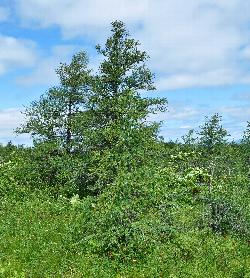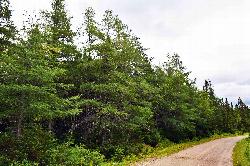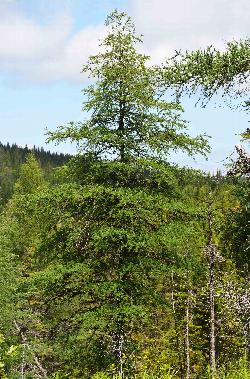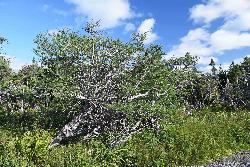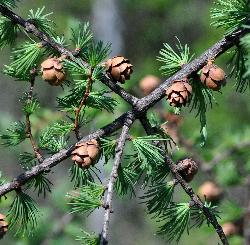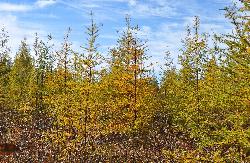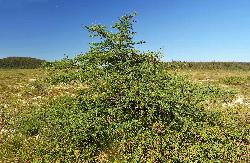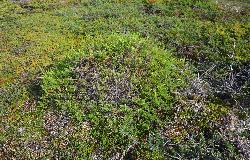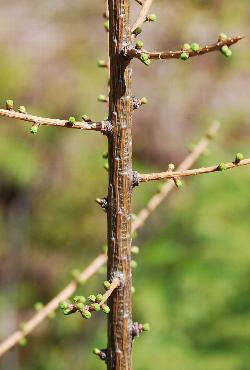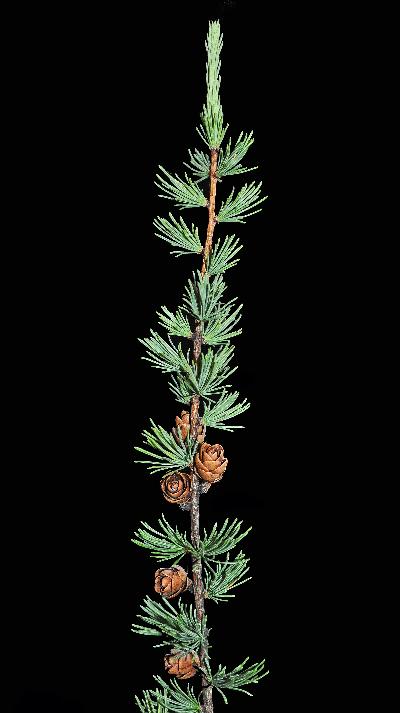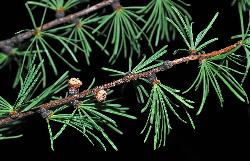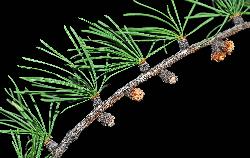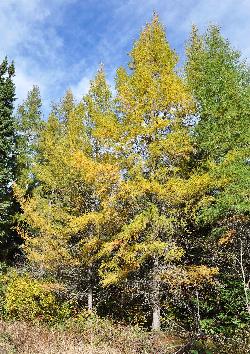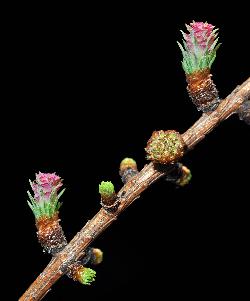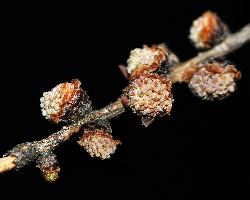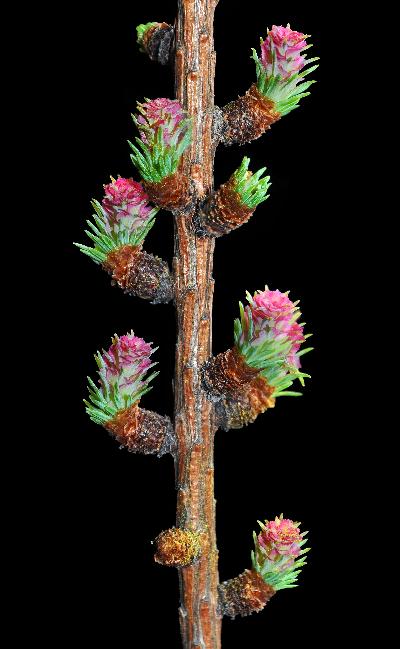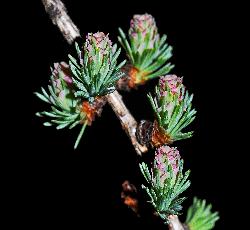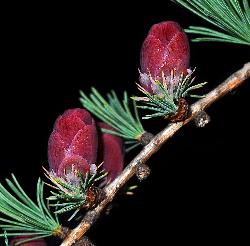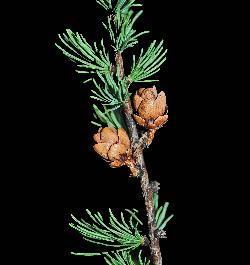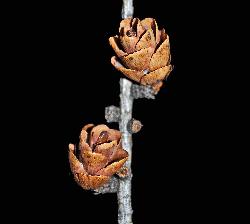Fr: mélèze laricin, tamarac, mélèze d'Amérique
IA: uatshinakan, uatshinakan-ushkuetui (cone)
Pinaceae - Pine Family
Note: Numbers provided in square brackets in the text refer to the image presented above; image numbers are displayed to the lower left of each image.
General: An open, medium-sized, deciduous conifer, 15–20 m tall, with a d.b.h. of about 40–60 cm, and living to about 150 years (Farrar 1995). Tamarack has a narrowly conical profile with horizontal to ascending branches [1–3], but on very exposed sites, its form is often stunted and irregular [4–5]. Tamarack can be easily recognized by its needles, which occur in tufts on short shoots. Tamarack has a shallow-rooted but wide root system, and is thus usually windfirm; it is also very shade-intolerant and is a pioneer species on peatlands and in-filling lakes, but is intolerant of flooding (Johnson 1990). Its shallow roots and thin bark makes it susceptible to fir damage. Tamarack is of limited value to wildlife, but squirrels and small bird species feed on the seed and may nest in the branches (Johnson 1990).
Key Features:
- Needles are narrow, flat, soft, and borne on two types of shoots. New shoots (leaders) bear single needles attached directly to the new stem [6], while short (spur) shoots produce tufts of 15–60 needles [7].
- Needles are deciduous and turn yellow-orange in autumn before dropping [8].
- Seed cones are small and ovoid, 1–2 cm long, with 10–20 rounded cone scales [7].
- Tamarack is most commonly found in peatlands [9] and swamps, but may also be found growing prostrate or as krummholz in barren (heathland) habitats. Winter pruning, caused by extreme winds carrying ice crystals, kills growing buds above the snow cover in exposed sites, resulting in very low to prostrate forms of tamarack [10–12].
Stems/twigs: Young twigs are light reddish-brown and glabrous; older twigs are greyish-brown to grey. Twigs have dark reddish-brown terminal and lateral buds that are scaly and blunt to rounded [13]. Young stems and trunks of saplings have dark reddish-brown vertical ridges (from the decurrent leaf bases) against a dark brown background [14], while the bark of mature trees is gray to reddish-brown and scaly. Two types of shoots are produced on larch species: long shoots and spur shoots [15]. New long shoots, or leaders, are terminal, slender, with individual needles attached spirally along the shoot; leaders produce both terminal and lateral buds, and are responsible for vertical and horizontal growth of the tree. Spur shoots are short stout shoots, borne laterally on year-old and older stems, and produce new tufts of needles each year; spur shoots produce terminal buds, but do not produce lateral buds. Rows of minute leaf scars are often visible at the top of spur shoots.
Needles: Deciduous, simple, and sessile. Needles are slender, soft, glabrous, 2–3 cm long, green to bluish-green, and flat above with a prominent midrib beneath [16–17]. Two thin white parallel lines (rows of stomates) run along the lower surface of each needle; the tips of the needles are blunt to rounded. On long shoots, needles are spirally arranged and attached directly to the stem by flat decurrent woody bases [15]. On spur shoots, needles are crowded in terminal tufts of 15–60 [18]. Larch needles turn golden-yellow to yellow-orange in autumn before falling [8, 19].
Reproductive structures/cones: Unisexual (trees monoecious), with separate male and female cones appearing on the same main branches and emerging with the needles [20–21]. Male cones consist of a low rounded cluster of light brown anthers [22–23] terminating a 1- or 2-year-old spur shoot that lacks needles. Emerging female cones (conelets) are rose-pink, ovoid, terminal on 2- or 4-year-old leafy spur-shoots, and subtended by tufts of needles [24–25]. Immature seed cones are dark reddish-purple [26]; mature cones are brown, ovoid, 1–2 cm long, and have 10–20 rounded cone scales [27–29], which exceed the subtending bracts. Cones develop in late spring and mature in fall; the winged seeds are shed from persistent cones at the end of the first growing season.
Ecology and Habitat: Tamarack occurs throughout the province; its outlier location on the Koroc River near the Québec-Labrador border, is much further north than other tree species. Tamarack can grow on a wide range of soil conditions, but is most common in open swamps and peatlands. It displays its best growth on wet seepage areas where it can out-perform black spruce. Tamarack can survive fire and is often present as an early successional species on burns. However, it is shade-intolerant and is consequently replaced by black spruce or balsam fir on upland sites. Tamarack is cold hearty and occurs in stunted forms through most of the treeline. It can also be observed invading exposed barren sites, where it does better than other conifers because of its deciduous habit. Tamarack out-performed all other species in heathland afforestation trials on exposed upland barrens of eastern Newfoundland.
Edaphic Grid: See image [30]: the Edaphic Grid for Larix laricina.
Forest Types: Tamarack is most abundant and vigorous on eutrophic wet sites, including the following forest types:
- Alneto-Piceetum (Alder-Black Spruce Swamp Association)
- Carici-Piceetum (Carex-Black Spruce Fen Association)
Tamarack-dominated forests are very rare and, therefore, not formally recognized in the overall forest classification. However, Damman (1967) described a Larix-Alder Type on calcareous marine deposits from Point aux Mal. These swamps have an open tamarack canopy with an understorey of speckled alder (Alnus incana subsp. rugosa). Tamarack also occurs sporadically in the Kalmio-Piceetum typicum (Kalmia-Black Spruce Forest Subassociation) and the Kalmio-Piceetum cladonietosum (Cladonia-Kalmia-Black Spruce Forest Subassociation).
Occasionally, tamarack can be a significant component of the barrens, but rarely forms a closed forest canopy. Because their bark is somewhat resistant to fire, tamarack can sometimes survive fire. In areas where there have been repeated fires, such as barrens subject to prescribed burning for blueberry production, the presence of bare mineral soil aids seedling establishment and survival, but usually not in quantities adequate to form a continuous forest. Tamarack may also establish where severe wind exposure has eroded the humus soil. Its deciduous habit spares tamarack needles from the abrasive force of wind-driven ice crystals, allowing it to grow where other species cannot. Where used in afforestation trials on very exposed sites on the Isthmus of Avalon, tamarack formed a stunted forest, while other coniferous species did not survive or assumed a krummholz growth form.
Succession: Tamarack can occur as an early successional species on burns and cutovers, but is shade-intolerant and rapidly replaced by balsam fir and black spruce in mature forest on upland sites. Tamarack is only known to reproduce vegetatively in treeline habitats.
Distribution: Tamarack has a very wide range across North American. In Canada, it extends west along the northern tree line from Newfoundland and Labrador to the Yukon, and south to northeastern British Columbia, central Alberta, and southern Manitoba. In the United States, its main range extends from Maine west to Minnesota and Wisconsin, and south to northernmost Illinois, Indiana, Ohio, Pennsylvania, and New Jersey. A large disjunct region of tamarack is found in interior Alaska, between the Brooks and Alaska Ranges (Johnston 1990).
Similar Species: There are no other deciduous conifers native to Newfoundland and Labrador, and tamarack is the only native larch in the province, but European larch (Larix decidua Mill.) and Japanese larch (Larix kaempferi (Lamb.) Carrière) have been used in plantation trials; these can be differentiated by their much larger size (to 30 m tall), longer (2–5 cm long) and more numerous needles (30–55 in each tuft), and larger cones (2–5 cm long). Japanese larch has wider cones with slightly reflexed cone scale tips, while European larch has cone scales that curve inward slightly at the tip.


